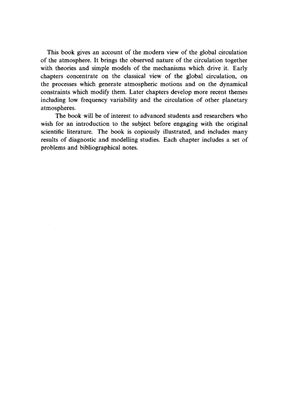Cambridge University Press, 1995, 422 Pages
This book gives an account of the mode view of the global circulation of the atmosphere. It accounts for the observed nature of the circulation and theories and simple models of the mechanisms that drive it. Early chapters concentrate on the classical view of the global circulation, on the processes that generate atmospheric motions, and on the dynamical constraints that modify them. Later chapters develop more recent themes including low frequency variability and the circulation of other planetary atmospheres. Each chapter includes a set of problems.
The book will be of interest to advanced students and researchers who wish for an introduction to the subject before engaging with the original scientific literature. The book is copiously illustrated, and includes many results of diagnostic and modelling studies. Each chapter includes a set of problems and bibliographical notes.
The goveing physical laws
Observing and modelling global circulations
The atmospheric heat engine
The zonal mean meridional circulation
Transient disturbances in the midlatitudes
Wave propagation and steady eddies
Three-dimensional aspects of the global circulation
Low frequency variability of the circulation
The stratosphere
Planetary atmospheres and other fluid systems
This book gives an account of the mode view of the global circulation of the atmosphere. It accounts for the observed nature of the circulation and theories and simple models of the mechanisms that drive it. Early chapters concentrate on the classical view of the global circulation, on the processes that generate atmospheric motions, and on the dynamical constraints that modify them. Later chapters develop more recent themes including low frequency variability and the circulation of other planetary atmospheres. Each chapter includes a set of problems.
The book will be of interest to advanced students and researchers who wish for an introduction to the subject before engaging with the original scientific literature. The book is copiously illustrated, and includes many results of diagnostic and modelling studies. Each chapter includes a set of problems and bibliographical notes.
The goveing physical laws
Observing and modelling global circulations
The atmospheric heat engine
The zonal mean meridional circulation
Transient disturbances in the midlatitudes
Wave propagation and steady eddies
Three-dimensional aspects of the global circulation
Low frequency variability of the circulation
The stratosphere
Planetary atmospheres and other fluid systems

